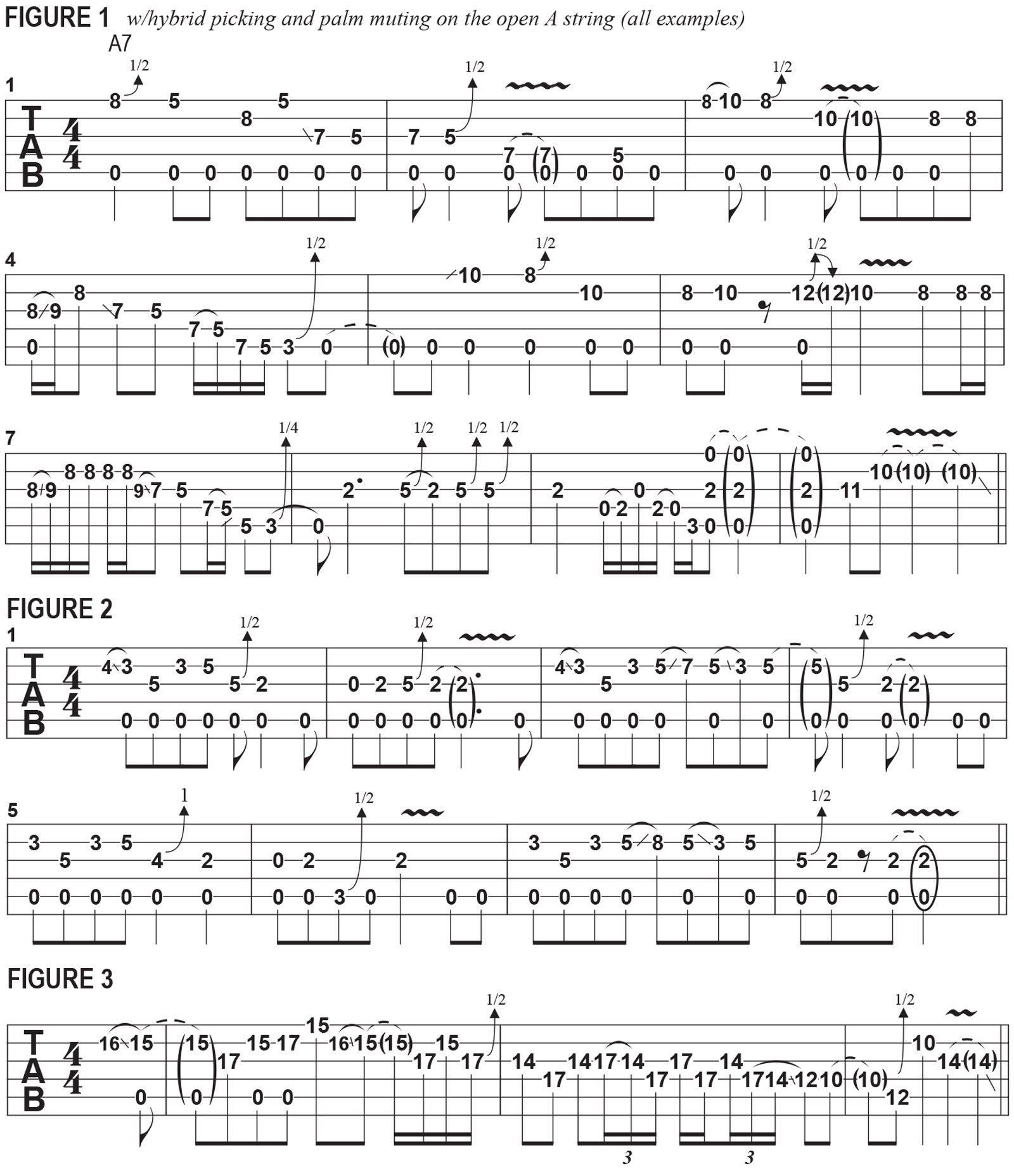Expanding on Drone-Based Ideas for Riffs and Solos
Learn how one can apply position shifts in conjunction with the droning technique to broaden the melodic possibilities of a given lick or phrase.
In this final installment of our examination of drone-based ideas, I’d like to demonstrate how one can apply position shifts in conjunction with the droning technique to broaden the melodic possibilities of a given lick or phrase.
Once again, we’ll use a constant open-string drone as the root note, which serves to provide a repeating reference to the tonic, or “home key,” as a harmonic frame of reference. In these examples, I’ll use the open A string, and the melodic lines will be based on the A minor pentatonic scale (A C D E G) with brief reference to the A blues scale (A C D Eb E G).
FIGURE 1 begins with melodic lines based on A minor pentatonic played in fifth position. In order to strengthen the reference to A7 and the dominant-seven sound, most of the minor thirds, C in the key of A, are bent up slightly toward C#, making reference to the major third, which, in conjunction with the minor, or “flatted,” seventh, G, conveys an A dominant-seven tonality. Keep in mind that the chord tones of A7 are A, C# E and G.

These four chord tones will carry the most weight melodically, so starting or stopping on any of them will always sound good. Allotting for the C-to-C# trade-off, the only note in the A minor pentatonic scale that is not a chord tone is D, the fourth of A. If one were to simultaneously sound a C# and a C, octaves apart, the C note, normally designated as the minor third, is thought of as a sharp nine (#9) because the third of the chord is represented as major with the presence of C#.
In order to repeatedly pick the open A string drone while simultaneously playing a melodic line on the higher strings, I employ hybrid picking, flatpicking all of the open A notes and fingerpicking the majority of the melodic notes on the higher strings. This technique approach is a staple of country and acoustic blues guitar playing and is a technique that’s also widely exploited by electric blues players.
Another important element in the pick attack involves slight palm-muting of the open-string drone: lightly rest the edge of your pick-hand palm across the lower strings next to the bridge saddles to achieve a “choked,” percussive sound, while allowing all of the higher strings to ring as clearly as possible. In bar 9, I use a “rolling” picking technique to sound the fifth, third and first strings in quick succession, low to high.
In FIGURE 2, I move the melodic phrase down to second/third position, which serves to emulate an “open A tuning” type of sound, used to great effect by blues guitar legend John Lee Hooker. A great way to expand on the way in which these melodic phrases fall on the fretboard is to simply move them up an octave to 14th/15th position, as illustrated in FIGURE 3. You’ll hear this kind of expanded approach in the playing of ZZ Top’s Billy Gibbons, a player whose style is greatly influenced by Hooker, as exemplified by the classic ZZ Top track “La Grange.”
Get The Pick Newsletter
All the latest guitar news, interviews, lessons, reviews, deals and more, direct to your inbox!
Guitar World Associate Editor Andy Aledort is recognized worldwide for his vast contributions to guitar instruction, via his many best-selling instructional DVDs, transcription books and online lessons. Andy is a regular contributor to Guitar World and Truefire, and has toured with Dickey Betts of the Allman Brothers, as well as participating in several Jimi Hendrix Tribute Tours.








![Joe Bonamassa [left] wears a deep blue suit and polka-dotted shirt and plays his green refin Strat; the late Irish blues legend Rory Gallagher [right] screams and inflicts some punishment on his heavily worn number one Stratocaster.](https://cdn.mos.cms.futurecdn.net/cw28h7UBcTVfTLs7p7eiLe.jpg)


